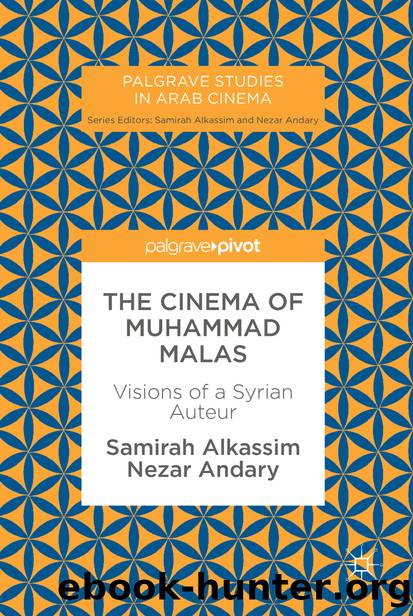The Cinema of Muhammad Malas by Samirah Alkassim & Nezar Andary

Author:Samirah Alkassim & Nezar Andary
Language: eng
Format: epub
ISBN: 9783319768137
Publisher: Springer International Publishing
Moudarres (1995)
Moudarres was co-produced by the Institute du Monde Arabe (Institute of the Arab World) in Paris and made by the same trio of filmmakers as above. It interrogates and documents one of the most famous modern Arab artists, the surrealist painter Fateh Moudarres (1922â1999), who like Malas did not just see himself as an artist of oil paintings, but also as a writerâand he was a prolific writer of short stories and prose. In 1999, the novelist, Abdul Rahman Munif described Moudarres artistic expression as a school onto itself, and in Moudarresâs obituary Munif emphasized that he was layered as a thinker, writer, and colleague. 39 Moudarres taught in Damascus at the Fine Arts College and was considered Syria âs most accomplished painter from the beginning of the 1960s. For many people, he represented a unique kind of modernism among Arab painters and was considered a public intellectual similar perhaps to Picasso. His paintings continue to sell in the most prestigious auction houses like Christieâs and Bonhamâs, and his work can be found in the Guggenehim Museum.
Like Light and Darkness, the film Moudarres has a reflexive relationship to Malas and his colleagues, who were all trying to understand their place as filmmakers in Syria. Similarly, Moudarres, the artist was puzzled by how modernity afflicted Syrians. Although his paintings had been compared to Miro and Picasso, he confessed to the camera his belief that true authentic modernity was not possible for Syrian artists. The character of Moudarres that evolves in the film is perhaps similar to many post-colonial Syrian artists, who like Malas strive for an aesthetic authenticity. One common experience they all sharedâShahbandar, Malas, Amiralay, Mohammed, and Mudarresâwas the problem of expressing dissent in an authoritarian state that allowed a very limited palette and expressive vocabulary for artists. Early in the film in an extreme close-up, Mudarres tells us how as an artist he practiced two forms at once, claiming that he was a musician practicing painting. As the camera holds on the close-up showing him nearly in tears, the poignancy of his fragility penetrates through. Moudarres, like Malas, expresses anxiety about the meaning of his work in relation to the state and to the larger world. Many times the film brings us into these personal anxieties.
Like the other films of gratitude, Moudarres also pays homage to a historical figure in the arts who though famous was not well understood in Syria . The film presents him as more than just a painter, but a model who inspires writers, filmmakers, and other artists searching for expression. At a screening at the French Cultural Institute in Damascus in 2009, the filmmakers stated that their goal was to allow Moudarres to reveal his unique personality in a documentary. 40 As with their film on Shahbandar, the synergy between filmmakers and with the subject gave Mudaress the space to reveal himself. This creation of space for the subject to self-reveal is achieved by the filmmakers taking the time to create meaningful mise-en-scène, something which Malas is always careful to do.
Download
This site does not store any files on its server. We only index and link to content provided by other sites. Please contact the content providers to delete copyright contents if any and email us, we'll remove relevant links or contents immediately.
The Japanese by Christopher Harding(1085)
Watercolor With Me in the Forest by Dana Fox(753)
A Theory of Narrative Drawing by Simon Grennan(742)
The Story of the Scrolls by The Story of the Scrolls; the M(725)
Glittering Images: A Journey Through Art From Egypt to Star Wars by Camille Paglia(717)
Boris Johnson by Tom Bower(620)
This Is Modern Art by Kevin Coval(597)
The Art and Science of Drawing by Brent Eviston(588)
Frida Kahlo by Frida Kahlo & Hayden Herrera(584)
AP Art History by John B. Nici(574)
Banksy by Will Ellsworth-Jones(569)
War Paint by Woodhead Lindy(551)
Van Gogh by Gregory White Smith(547)
Draw More Furries by Jared Hodges(544)
About Looking by John Berger(543)
Scenes From a Revolution by Mark Harris(542)
Ecstasy by Eisner.;(535)
100 Greatest Country Artists by Hal Leonard Corp(523)
Young Rembrandt: A Biography by Onno Blom(512)
